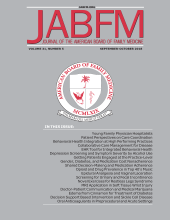To the Editor: Dr. Whitcomb's1 suggestions for training family medicine residents in the continuing care of patients with chronic illnesses are excellent. Continuity of care with a panel of patients and problem-based learning around those patients are excellent alternatives to the disjointed collection of clinics, lectures, and specialty outpatient rotations that are often used to meet training requirements. However, his abandonment of inpatient training throws the baby out with the bathwater.
The role of a personal physician for the patient in the hospital is still a critical one. Hospitalist models do fulfill this role well in some settings and are an alternative for primary care physicians who choose to opt out of hospital care. However, many office-based generalists still find the time and maintain the expertise to provide high-quality hospital care for their patients. Both physicians and patients often find this to be a much more satisfying and successful relationship than one where the patient is “handed off” to a hospital physician. In this era of 2-day admissions, step-down units, home health care, etc, transitions between these many settings are often best managed by a personal physician who is integrated into these systems. Furthermore, evidence suggests that while hospitalists may provide modest cost efficiency, they do not improve on the quality of care provided by community physicians.2
It may well be time to examine how inpatient care is taught. Work hour rules, short stays, high patient volumes, and documentation requirements are certainly affecting how much medicine is being learned by inpatient residents. New models such as following continuity patients in the hospital may be a better alternative to some portion of traditional inpatient rotations. But taking family physicians out of the hospital will be a step away from providing patients with a true personal physician, and I see no evidence that family medicine is ready to, or should as a matter of quality, abandon hospital care.







